Bruce McCandless and His Flying Machine
The astronaut who pioneered the MMU jetpack recounts the history of one of NASA’s greatest inventions.
:focal(411x15:412x16)/https://tf-cmsv2-smithsonianmag-media.s3.amazonaws.com/filer/64/2b/642b91fc-4018-427d-8425-c9a935b88ee6/mccandless_in_flight.jpg)
Astronaut Bruce McCandless II, who died last December at the age of 80, was a principal designer and the first test pilot of NASA’s Manned Maneuvering Unit, first flown on shuttle mission STS-41B in February 1984. McCandless gave this talk about the development of the jetpack in 2015, at an Association of Space Explorers’ meeting in Stockholm, Sweden. Fellow astronaut Tom Jones—who wishes he had gotten to fly the MMU himself—was there, and has condensed and edited McCandless’ s remarks.
When I was growing up, we didn’t have astronauts. But we did have comic strips—Flash Gordon, Buck Rogers, people of this sort. When I mentioned to my parents that I wanted to fly like Buck Rogers, they would say, “Well, man may eventually fly in space, but surely not before the year 2000. So why don’t you come down to Earth and do something practical, like learn to drive a battleship, or something of that sort.”
Instead of learning how to drive a battleship, I opted to go into the U.S. Naval Academy, and was firmly committed to nuclear submarines, the first of which, the USS Nautilus, had come to the Naval Academy on a visit. I was headed in that direction until one afternoon in October 1957, when we heard that a Sputnik had been launched. I happened to have a short-wave receiver in my room as a lordly senior upperclassman, and so we dropped a wire out the window, five stories down to the moat, and we were actually able to receive the beep-beep-beep as Sputnik went by.
I’d like to talk a bit about maneuvering units. They’re sort of a personal rocket propulsion system. Immediately after my [flight] with the MMU, I was surprised that the French came out calling it “The Flying Armchair,” harking back to man’s first experiment with rocket propulsion, which I was told was conducted by a Chinese emperor early in the first millennium A.D.
Now this is not so farfetched as you might believe, because Zvezda in the Soviet Union built a solid propellant maneuvering unit. [It had] little, individual solid rocket motors, with a similar array on the back. When the hand controller was activated, it electrically stepped through and fired the next solid motor in sequence. Fortunately, this was never flown in space.
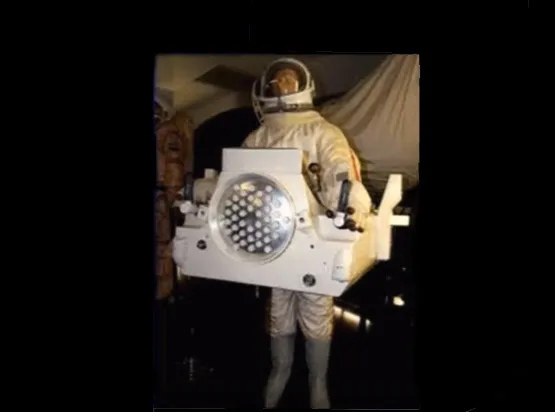
The first spacewalk was by our friend, Alexei Leonov. During his EVA, which was in the spring of 1965, a time when we were very competitive with the Soviet Union, General Leonov had about 12 minutes of spacewalking. We in the U.S. had to top that, of course, so three months later, Ed White came out and did twice that duration, 23 minutes, putting us back in the game.
Ed was using a unit called the Handheld Maneuvering Unit. It basically had a couple of small cylinders of gas in the grip, and you could either fire one thruster away from you, or two thrusters in a tractor mode pulling you. This was an elegant, simple concept that was fiendishly difficult to operate properly, and we spent at least the next 12 years trying to kill off that concept. And it kept coming back from the ashes, somewhat like the Phoenix.
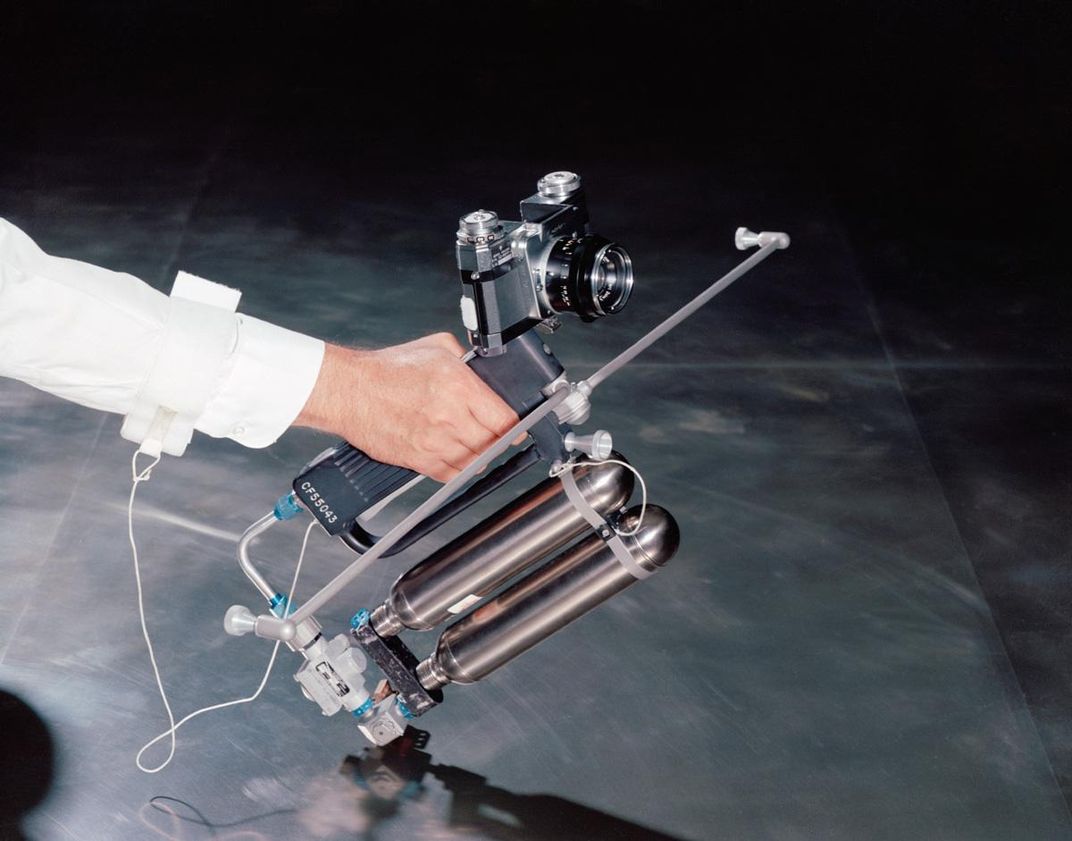
Our next step in the line of maneuvering units was a device built under contract to the U.S. Air Force. This was the so-called Astronaut Maneuvering Unit. It had hot gas thrusters fed by the decomposition of hydrogen peroxide. You’ll note that the subject shown [below], Ed Givens, one of my compatriots—he died in an automobile accident—is wearing stainless-steel mesh trousers to prevent him from getting the proverbial hot seat from those hot-firing thrusters.
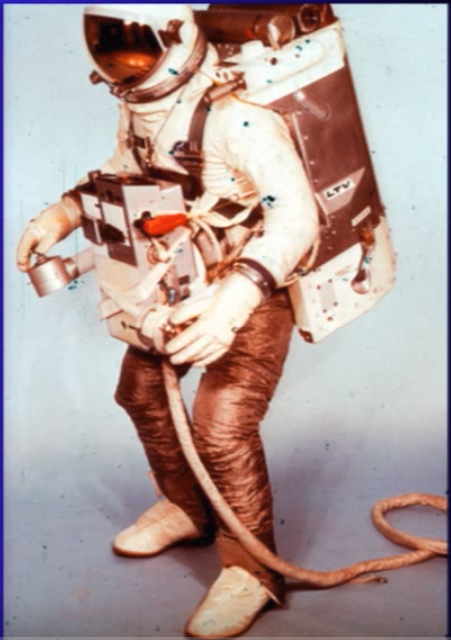
This unit was flown on Gemini 9, with Gene Cernan to test it. This was the United States’ second spacewalk, the first one to involve real physical exertion, and the technology was not up to it. Gene became very overheated, with the visor of the suit so fogged up that he couldn’t see out. It was almost an emergency—Tom Stafford, the commander, canceled the spacewalk and brought him back inside. That experience gave maneuvering units in general a bad name.
It was about this time that I came on the scene in the summer of 1966, and with two other individuals, decided to see if we couldn’t rehabilitate the concept of maneuvering units. So we proposed an experiment to be flown inside the Skylab workshop, which had about 22 feet (7 meters) worth of flying space.
The concept called for a nice, svelte maneuvering unit that fit on your back, and that could be carried through an airlock. As we progressed through the design reviews, this [below] is what we wound up with. I’m in the suit in all three cases, and I can assure you that being bent over like this is because of my supporting the weight of the unit.
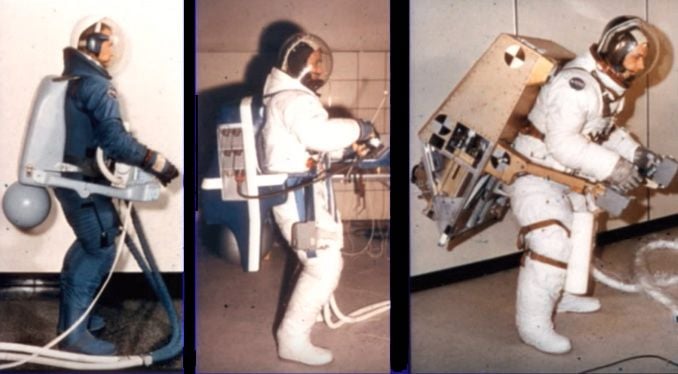
Nonetheless, as a maneuvering unit it did fly quite successfully. We simulated it in a large, six- degree-of-freedom moving-base simulator, where you can go 20 meters vertically and about 6 meters side-to-side and up and down, using a three-axis gimbal system. Later, in flight, Alan Bean and four others actually flew the M-509 experiment inside the Skylab workshop. We used that data to proceed towards developing the Manned Maneuvering Unit.
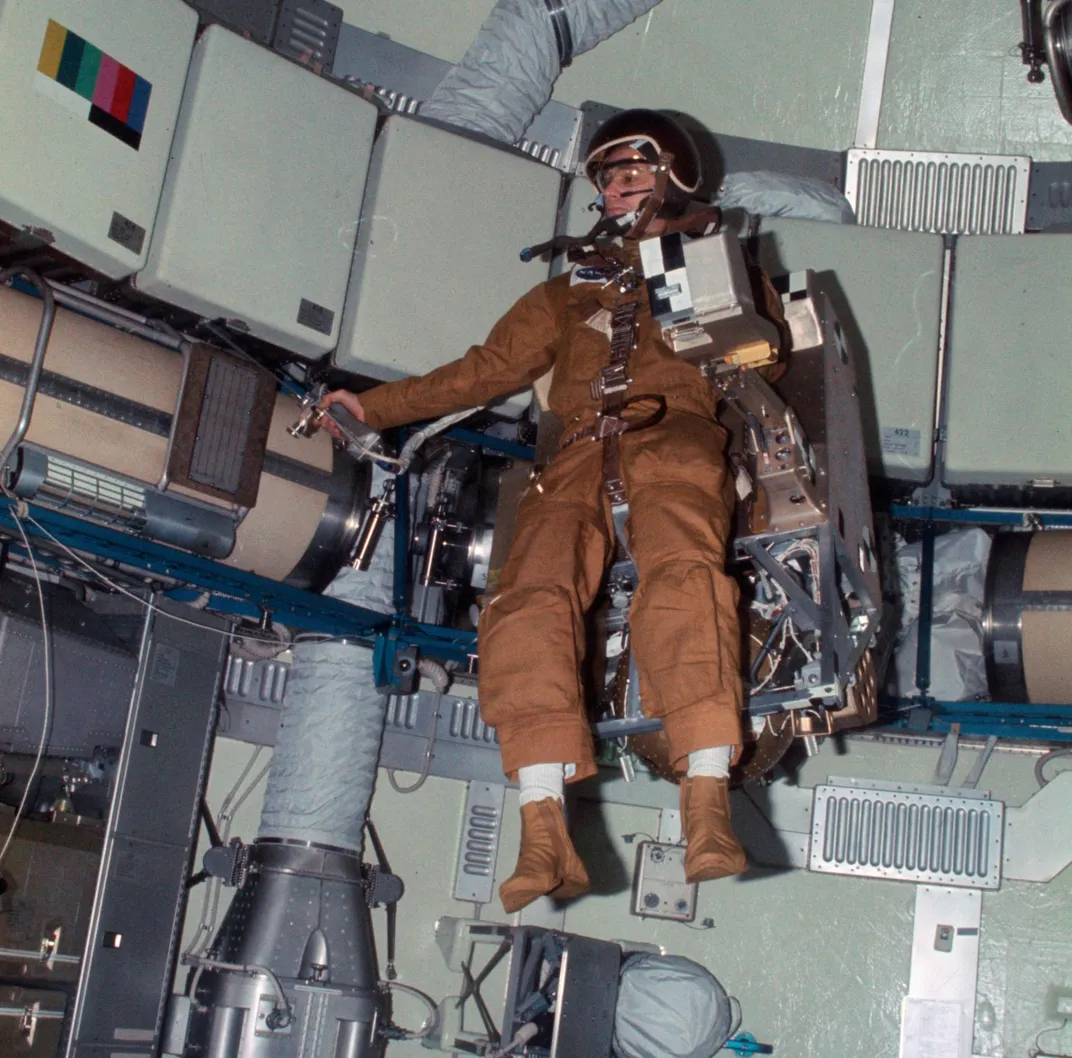
Our concept for the space shuttle was a unit mounted in a flight support station, in the payload bay, in vacuum. [The astronaut] would come out of the airlock, get in a foot plate, remove some launch restraint bolts, check it out, service it, back into it, [and go]. There was no connection between us [and the MMU] other than a mechanical latch and a seat belt.
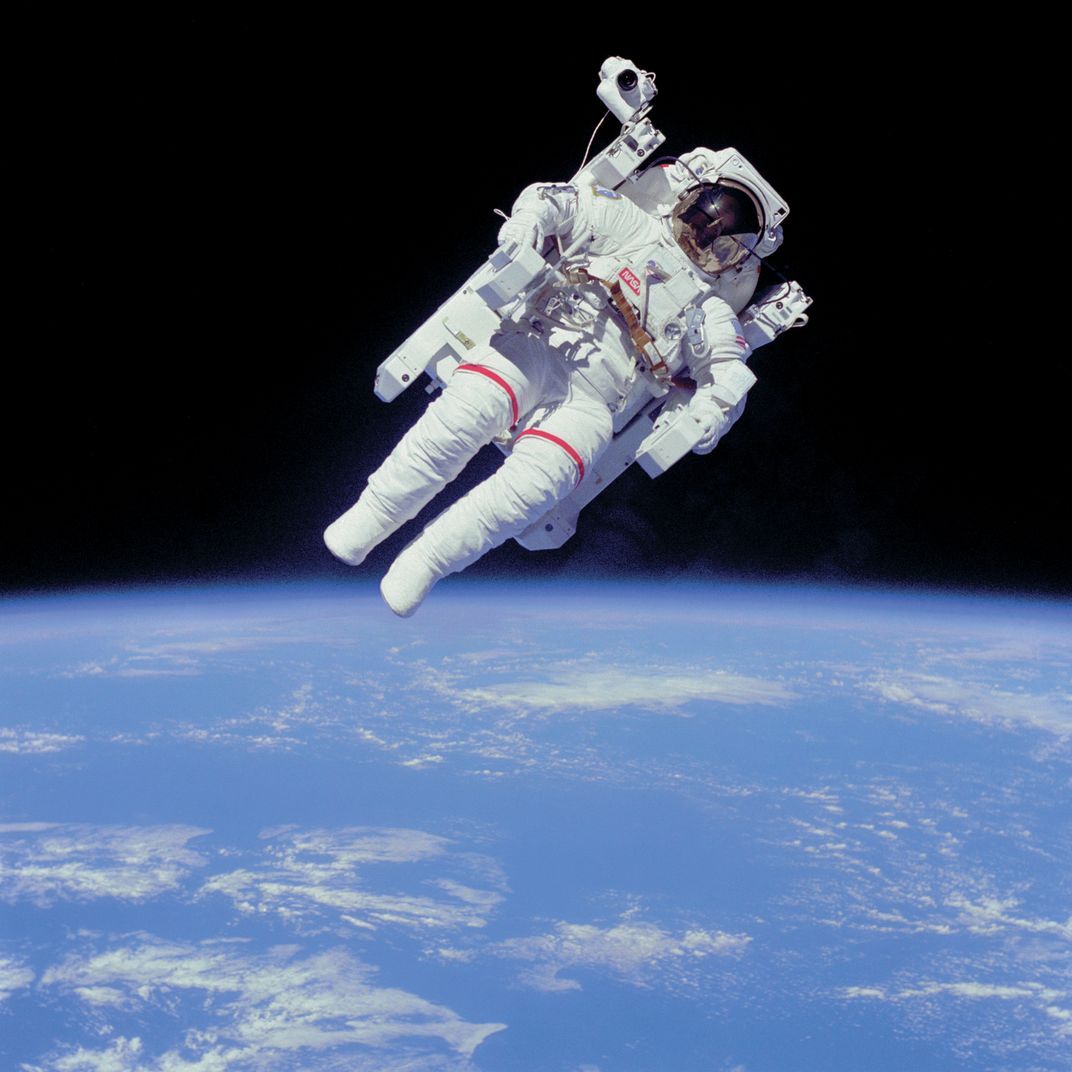
We tried it out on the 10th flight of the shuttle, STS-41B. After four days my partner, Bob Stewart, and I set out and flew the [MMU] very uneventfully. I had been involved in the design and development of the unit, and as I backed away from Challenger, this [below] was my perspective. You can see Bob in the payload bay, trying to get into the foot restraint on the end of the manipulator arm.
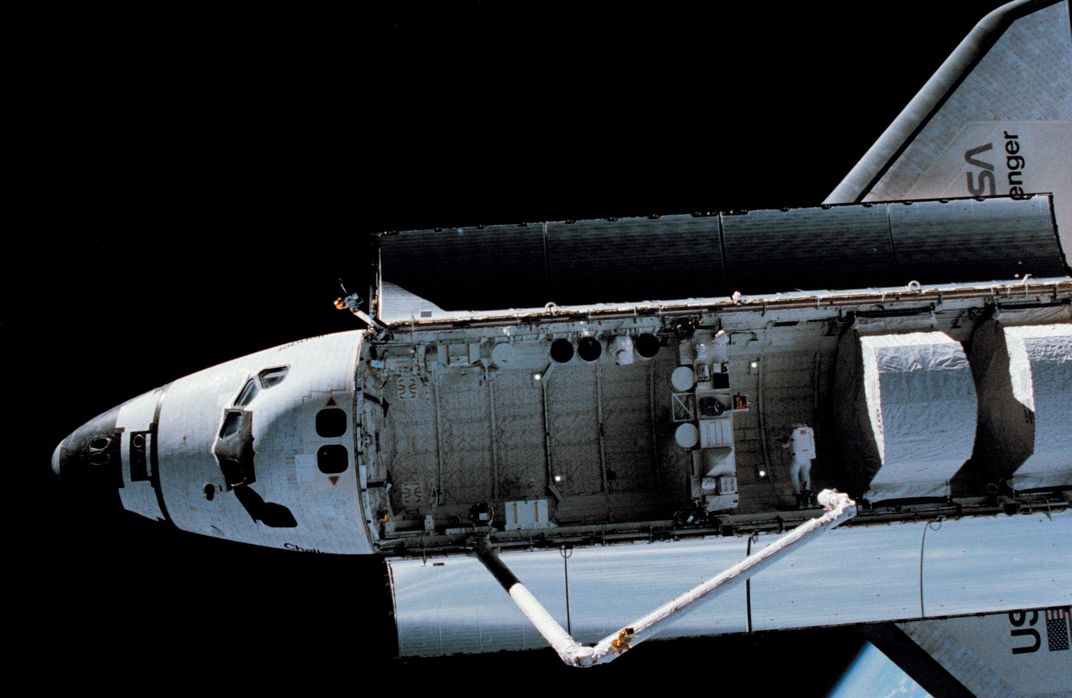
As I got farther away, the only range-finding device that I had was something that NASA called the solid-state range finder. This was a piece of aluminum bar stock that was held out at arm’s length. It had notches cut into it that said “100 feet, 200 feet, 300 feet,” based on the size of the payload bay. I successfully went out about 100 meters, which was the plan, and came back in.
One of the surprises, though, was that when I got out away from the shuttle, I became very cold. I was out away from the payload bay, so I wasn’t getting any heat reflected back into the pressure suit. We had a big knob on the front of the suit’s [display and control module] marked “C” on one end, with several gradations, and “H” on the other [for temperature control]. Naively, I thought that H stood for hot, but H really stands for “not quite so cold.” The suit was designed to support someone doing honest physical work in the space environment, and flying the manned maneuvering unit was a matter of using your fingertips. So, my metabolic load was extremely low, and I got cold.
This was early in the program, and the heat rejection system was a sublimator—a porous plate that had ice formed on the outside. Water was fed from the inside to the outside, and as the ice formed it took heat away. Inside the plate you had a cooling tube that circulated water through the lines that were laced through the liquid cooling garment. The ground rule was “never turn off the sublimator,” because if you try to restart it, it may malfunction and blow all the water out. Well, I got so cold that finally Mission Control agreed that this was a situation where we had to try it. I switched off the sublimator, and about 15 minutes later I was comfortably warm again; I switched on the sublimator, and it started working, no problem. We had put to rest another bugaboo in the space program. So far as I know it has never failed to properly start, or restart.
The MMU was used on two other space shuttle missions. One was the repair of the Solar Maximum Mission, and the other was the retrieval of two satellites, later in 1984. Following the Challenger accident, however, NASA opined that it did not have enough money to recertify it for flights on the new shuttle. We had also developed a maneuvering technique [with the shuttle] called “Low Z”, which allowed us to drive right up to a satellite without the thrusters impinging on it, which reduced the necessity for the manned maneuvering unit.
As we look toward the future, the Orion spacecraft is being designed for visits to the Moon and bodies like asteroids and Mars. I think that we will find the need for a maneuvering unit to get around the surface of an asteroid. There don’t seem to be any handholds there, and I don’t think you can walk on it or leave footprints on an asteroid. I think that a maneuvering unit would be the way to explore it, and to put a belt or cargo net around it, so it can be attached or moored to an Orion spacecraft.